Mark Anthony Neal's Blog, page 454
June 10, 2018
Race and America's Long War: A Conversation with Nikhil Pal Singh
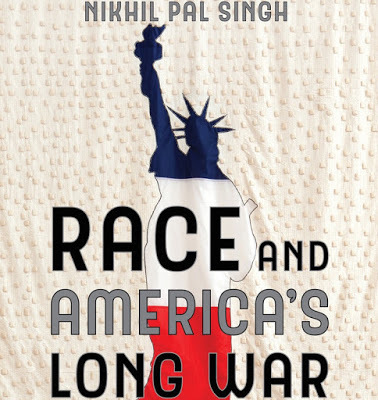 Talking Stick TV
interviews Nikhil Pal Singh, author of Race and America's Long War (University of California Press). Singh is Associate Professor of Social and Cultural Analysis and History at New York University and the founding faculty director of the NYU Prison Education Program.
Talking Stick TV
interviews Nikhil Pal Singh, author of Race and America's Long War (University of California Press). Singh is Associate Professor of Social and Cultural Analysis and History at New York University and the founding faculty director of the NYU Prison Education Program.
Published on June 10, 2018 18:39
#ReturnOfTheBoomBap – Visuals & Sonics for Phonte Coleman's 'So Help Me God"
 Sonics and visuals for Phonte Coleman's "So Help Me God" from No News Is Good News, featuring a cameo from Omar Dorsey (Queen Sugar's "Hollywood").
Sonics and visuals for Phonte Coleman's "So Help Me God" from No News Is Good News, featuring a cameo from Omar Dorsey (Queen Sugar's "Hollywood").
Published on June 10, 2018 18:28
June 8, 2018
Left of Black S8:E24: Reinventing Black Womanhood in Washington, D.C.

Left of Black S8:E24: Reinventing Black Womanhood in Washington, D.C.
Left of Black host Mark Anthony Neal is joined by scholar and author Treva Blaine Lindsey (@divafeminist), author of Colored No More: Reinventing Black Womanhood in Washington, D.C. (University of Illinois Press, 2017), which noted Historian Martha S. Jones describes as “Fresh research, illuminated by feminist theory” that “reveals how 'New Negro Womanhood' became a framework through which African American women developed modern identities.”
Lindsey, who is Associate Professor of Women's, Gender, and Sexuality Studies at The Ohio State University, returned to Duke University, where she earned a Ph.D. in 2010, as part of the Symposium, Black Women, Black Studies and Knowledge Production . In her book Professor Lindsey presents New Negro womanhood as a multidimensional space that included race women, blues women, mothers, white collar professionals, beauticians, fortune tellers, sex workers, same-gender couples, artists, activists, and innovators.
Published on June 08, 2018 20:39
Unbound: Darnell L. Moore
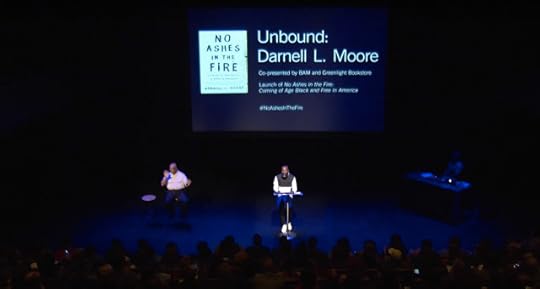 'Writer and activist Darnell L. Moore celebrated the launch of his memoir,
No Ashes in the Fire: Coming of Age Black and Free in America
(Nation Books), an honest reckoning with family, place, and what it means to be free. Moore hosted this interdisciplinary evening which featured a performance by dancer Déon Sass, with original music composed by Guthrie P. Ramsey, Jr; musical interludes by DJ Just Love; and a series of one-on-one conversations with authors and cultural critics Brittney Cooper, Marc Lamont Hill, Kierna Mayo and Darnell’s mother, followed by a panel and audience discussion on Black literature and the role of critics of color. Co-presented by BAM and Greenlight Bookstore.'
'Writer and activist Darnell L. Moore celebrated the launch of his memoir,
No Ashes in the Fire: Coming of Age Black and Free in America
(Nation Books), an honest reckoning with family, place, and what it means to be free. Moore hosted this interdisciplinary evening which featured a performance by dancer Déon Sass, with original music composed by Guthrie P. Ramsey, Jr; musical interludes by DJ Just Love; and a series of one-on-one conversations with authors and cultural critics Brittney Cooper, Marc Lamont Hill, Kierna Mayo and Darnell’s mother, followed by a panel and audience discussion on Black literature and the role of critics of color. Co-presented by BAM and Greenlight Bookstore.'
Published on June 08, 2018 19:27
60 Years of Alvin Ailey Dance
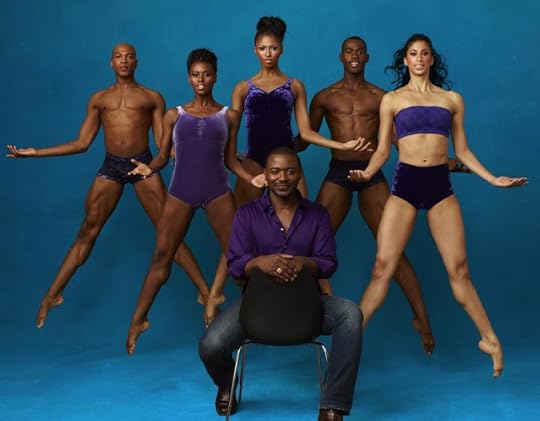 'Robert Battle, Alvin Ailey American Dance Theater’s Artistic Director, and company dancers Courtney Celeste Spears and Clifton Brown discuss their Lincoln Center engagement and the company’s upcoming 60th Anniversary this fall.' Midday on WNYC
'Robert Battle, Alvin Ailey American Dance Theater’s Artistic Director, and company dancers Courtney Celeste Spears and Clifton Brown discuss their Lincoln Center engagement and the company’s upcoming 60th Anniversary this fall.' Midday on WNYC
Published on June 08, 2018 04:26
Tiny Desk Concert: Daniel Caesar
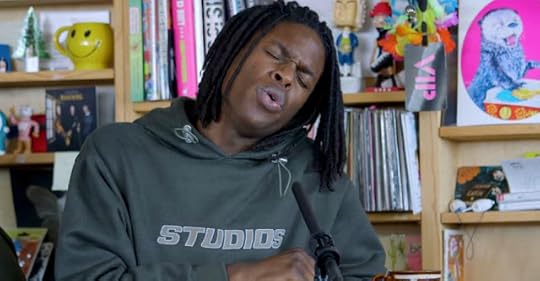 'Daniel Caesar and his band had a clear vision for their Tiny Desk performance. While already confined to a small space, they opted to congregate at the piano, where producer and music director Matthew Burnett sat to create what feels like a fly-on-the-wall moment. We're presented a purity that's nearly impossible to capture on an album.' --
NPR Music
'Daniel Caesar and his band had a clear vision for their Tiny Desk performance. While already confined to a small space, they opted to congregate at the piano, where producer and music director Matthew Burnett sat to create what feels like a fly-on-the-wall moment. We're presented a purity that's nearly impossible to capture on an album.' --
NPR Music
Published on June 08, 2018 04:16
Small Thing Big Idea: Kyra Gaunt on How the Jump Rope Got Its Rhythm
 '"Down down, baby, down down the roller coaster..." Hip-hop owes a lot of the queens of double dutch. Ethnomusicologist Kyra Gaunt takes us on a tour of the fascinating history of the jump rope.' --
TED
'"Down down, baby, down down the roller coaster..." Hip-hop owes a lot of the queens of double dutch. Ethnomusicologist Kyra Gaunt takes us on a tour of the fascinating history of the jump rope.' --
TED
Published on June 08, 2018 03:55
June 7, 2018
The Greatest Soul Album Ever? Johnnie Taylor’s ‘Taylored in Silk’ by Mark Anthony Neal

The Greatest Soul Album Ever? Johnnie Taylor’s ‘Taylored in Silk’ by Mark Anthony Neal | @NewBlackMan | NewBlackMan (in Exile)
Overshadowed by Isaac Hayes and others at the label that he helped to musically resuscitate, Johnnie Taylor recorded what might be the greatest Soul album.
The late Johnnie Taylor’s legacy is largely bookended by two sexually explicit singles: “Who’s Making Love”, a top-five Pop single from 1968, and “Disco Lady,” which topped the Pop charts for four weeks, eventually selling more than 2.5 million copies in 1976. To be sure Taylor was not the quintessential Black crossover artist – the success of both recordings could legitimately be thought of as flukes – but he was a paragon of the Soul Man tradition, with credentials that spanned nearly 50 years before his death in 2000. Nestled between those two massive hit singles was the album, Taylored in Silk (1973), which arguably could have been the greatest Soul album ever.
Johnny Taylor’s career began in Chicago in the early 1950s as a vocalist in The Highway Q.C.’s, a sort of Gospel finishing school; Taylor replaced Lou Rawls, who himself replaced Sam Cooke, to give some indication of the talent that the group helped incubate. Cooke departed the Highway Q.C.’s to become lead singer of The Soul Stirrers, and when he left the latter group in 1957 to pursue what would be a landmark career as a secular artist, Taylor was hired to replace Cooke as lead singer. Taylor latter joined Cooke at SAR Records, the label that Cooke had launched shortly before his murder. By 1966, Taylor found himself in Memphis, signing with Stax Records.
Taylor had minor success in his early days at Stax, landing on the upper tier of the Rhythm & Blues charts with tracks like “I Had a Dream” (1966) and “I Got to Love Somebody’s Baby” (1966). As talented as he was – a legitimate progeny of Sam Cooke – he was largely in the shadow of the legendary Otis Redding at Stax. Taylor’s fate changed when the label’s fate changed in a tragic turn of events: Otis Redding’s death in December of 1967 and the label’s loss of its entire catalogue to Atlantic Records in the following year.
It is in the context of Al Bell’s now famous rebuilding of the Stax catalogue – referenced recently in a similar storyline from the Fox series Empire – that Taylor recorded “Who’s Making Love” (1968), which sold close to a million copies in its first year and was Stax’s most successful single to that point. Written by Homer Banks, Bettye Crutcher, and Raymond Jackson, Taylor reportedly hated the song. As the song’s producer Don Davis recounts in Rob Bowman’s Soulsville, U.S.A., Taylor referred to the song as “the boogity boogity song” because of its fast pace.
In the aftermath of “Who’s Making Love?”, Bell fell into the grind at Stax producing a string of solid albums including Raw Blues, Rare Stamps and The Johnnie Taylor Philosophy Continues, which included Taylor’s cover of “(I Wanna) Testify”, originally recorded in 1967 by The Parliamentsbefore their Parliament Funkadelic formation. While singles like “Steal Away”, “I Am Somebody” – drawing on a theme from label-make Rev Jesse Jackson – and “Jody Got Your Girl and Gone” resonated with Black audiences – “Jody” topped the R&B charts – none of those singles matched the success of “Who’s Making Love?.”
And yet this was a peak era for Stax, which under Al Bell’s leadership, would enter a new distribution deal with CBS in 1972 and create a new cast of crossover Soul stars including the rebranded Staple Singers (“I’ll Take You There” and “Respect Yourself”), Luther Ingram (“(If Loving You Is Wrong) I Don't Want to Be Right”), The Dramatics (“Whatcha See is Whatcha Get” and “In the Rain”), and the label’s rainmaker Isaac Hayes.
By the time Taylor recorded One Step Beyond (1971) – easily his strongest recording to date – the Soul Man might have been an afterthought at the label he helped to musically resuscitate. It was the same ballad-heavy formula found on One Step Beyond that Taylor and producer Don Davis chose to revisit on his 1973 release Taylored in Silk.
Released a year after Isaac Hayes double-album masterpiece Black Moses and in an era where Black artists were encouraged to go large, Taylored in Silkfeatures just eight tracks and logs in at 35-minutes. The album was launched by the lead single “I Believe in You (You Believe in Me)”, written by Don Davis, which surprisingly became Taylor’s highest charting Pop single since “Who's Making Love?”.
As a slick mid-tempo “I Believe in You (You Believe in Me)” was the antithesis of Taylor’s most well known singles. No doubt the crossover success of tracks like Ingram’s “(If Loving You Is Wrong) I Don't Want to Be Right” and Harold Melvin and the Bluenotes, “If You Don’t Know Me By Now” a year earlier, created an appeal in the early 1970s for mid-tempo Soul ballads – indeed groups like The Main Ingredient, Blue Magic, and The Stylistics would find success in the era using such a formula. As Davis notes in Bowman’s Soulsville, U.S.A., CBS was surprised by the crossover appeal of the song, “They just didn’t believe that black artists could sell that many copies”; “I Believe in You (You Believe in Me)” sold more than a million copies.
The nut and bolts of the song, as described by Bowman, explains why the song and album registers as a classic of the Soul genre. According to Bowman, “I Believe in You (You Believe in Me)” was “the first record on which Don Davis constructed the track via layered riffs instead of functional chord changes. Davis referred to this as the “monolithic approach.’ The next result was a more melodic, Sam Cooke influenced Johnnie Taylor.”
The Cooke reference was not incidental; Taylor was one of the few Soul artists of the era, who could legitimately bridge the sensibilities of an older Rhythm & Blues audience – the grits and gravy crowd – and a younger Soul audience more attuned to the slick production of post-1968 Stax and the emerging Philly Soul sound of Kenny Gamble and Leon Huff. The album’s self-awareness of the tradition that helped produce its possibilities is what stands out. For example, the album closes with a cover of Dinah Washington’s “This Bitter Earth”, who died a decade earlier, but the song is not simply musical tribute, but a signpost for an artist whose influence on Rhythm & Blues and Soul could not be overstated. Though much is made of Gospel singer Clara Ward’s impact on Aretha Franklin in her peak, Washington’s was just as pronounced, if undervalued. At the time that Taylored in Silk was recorded, Franklin was, of course, the standard bearer of the Soul tradition, and Taylor’s cover of “This Bitter Earth” – which Franklin herself covered in a tribute album to Washington in 1964 – recovers Washington’s role in Franklin’s ascent for a younger audience.
The majority of Taylored in Silk was recorded at Muscle Shoals Sound Studio in Alabama, with the exception of the track “Talk to Me,” in which the rhythm tracks were recorded in Detroit. “Talk to Me” was a cover of one of the most well known songs by Detroit raised Little Willie John, whose brief career ended with his death in a prison hospital in 1968 at age 30. More than a musical footnote, John was, pound-for-pound, one of the most impressive performers of his generation; even the Godfather of Soul, James Brown was compelled to acknowledge the influence of his former label mate with a tribute album shortly after John’s death. As Gayle Wald writes “Little Willie John was a small man with a big voice, an outsized talent who could croon and growl, sing ballads and rhythm and blues, dig deep into his lower register and hit high notes that took the wind out of lesser tenors...not even James Brown, the Hardest Working Man in Show Business, wanted to follow Little Willie John on a bill.” ( LA Review of Books , 2011)
While Taylored in Silk clearly acknowledges the importance of the tradition, it was also making a claim on Taylor’s place within that tradition. The haunting intro guitar riff from the album’s opening track “We’re Getting Careless with Our Love” is as recognizable as any Stax record intro save, Hayes’s iconic “Theme from Shaft.” Like many of the songs on the album, “Careless” bring some nuance to the sub-genre of “infidelity Soul” that Stax promoted with Taylor, Ingram and The Soul Children. In line with that nuance Taylor’s take on Sir Mack Rice’s classic strut “Cheaper to Keep Her”, serves as a cautionary tale – “When your little Girl make you mad / And you get an attitude and pack your bags / Five little children that you're leaving behind / Son, you're gonna pay some alimony or do some time” – for the very story Taylor opens the album with. “Cheaper to Keep Her” updates Ray Charles’s classic live rendition of “Makin’ Whoopee” (1964).
Side one of Taylored in Silk includes a cover of Mel & Tim’s “Starting All Over Again”, which was the duo’s first Stax hit after the success of their 1969 single “Backfield in Motion”. The song was written by Prince Phillip Mitchell, who also penned Millie Jackson’s breakthrough hit “It Hurts So Good” (1973). In softening the edges of the Mel & Tim version, a top-10 Pop hit from a year earlier, Taylor’s version offered a reminder of the “new” Stax’s contribution to the Soul tradition.
Even tracks that might be thought of a filler like “One Thing Wrong with My Woman” – written by Tony Hester who wrote both “In the Rain” and “Whatcha See is Whatcha Get” for The Dramatics – and “I Can Read Between the Lines”, offer a sublime sweetness that few of Taylor’s peers, save Al Green or Ronnie Dyson, could generate.
After Stax collapsed in 1975, Taylor signed with Columbia/CBS and had his biggest hit with “Disco Lady.” Though Taylor would never again be relevant to Pop audiences, he was able to reinvent himself as a southern Blues singer -- much like Bobby Blue Bland and Denise LaSalle -- recording nearly a dozen albums for the Malaco label until is death in 2000. Taylor’s last hit was a track called “Good Love” (1996), which highlighted his stylistic and generational versatility, sounding as relevant as any of the R&B rank-and-file male vocalists of the mid-1990s.
+++
Mark Anthony Neal is Professor of African American Studies and Professor of English at Duke University, where he is Chair of the Department of African & African-American Studies. The author of several books including Looking for Leroy: Illegible Black Masculinities(NYU Press), Neal is the host of the video podcast Left of Black, now in its 8th season.
Published on June 07, 2018 20:59
New Ways to be Free: On Radicalism, Resistance and the Promise of Black Liberation
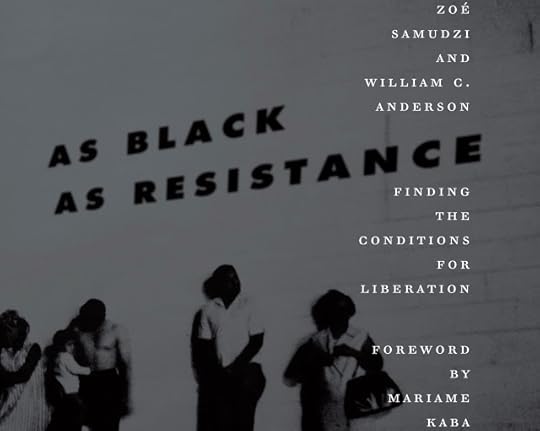 'Writers Zoé Samudzi and William C. Anderson look to the enduring, revolutionary promise of the Black radical tradition - as a diverse framework of ideas and tactics to resist systemic violence and White supremacy, and as a path towards liberation, notthisis just against the exclusionary state, but beyond it. Samudzi and Anderson are the authors of
As Black As Resistance: Finding the Conditions for Liberation
from AK Press.'
'Writers Zoé Samudzi and William C. Anderson look to the enduring, revolutionary promise of the Black radical tradition - as a diverse framework of ideas and tactics to resist systemic violence and White supremacy, and as a path towards liberation, notthisis just against the exclusionary state, but beyond it. Samudzi and Anderson are the authors of
As Black As Resistance: Finding the Conditions for Liberation
from AK Press.'
Published on June 07, 2018 04:29
Tiny Desk Concert: Trouble Funk
 'Go-Go — Washington D.C.'s regional twist on funk — reigned in the DMV during the 1980s, and one of the scene's signature acts was Trouble Funk. More than 30 years later, the collective, led by Big Tony Fisher, still fills sold-out venues with heavyweight percussion and call-and-response lyrics. Trouble Funk concerts are bona fide jam sessions, so NPR was determined to squeeze their unrelenting rhythms behind the Tiny Desk.'
'Go-Go — Washington D.C.'s regional twist on funk — reigned in the DMV during the 1980s, and one of the scene's signature acts was Trouble Funk. More than 30 years later, the collective, led by Big Tony Fisher, still fills sold-out venues with heavyweight percussion and call-and-response lyrics. Trouble Funk concerts are bona fide jam sessions, so NPR was determined to squeeze their unrelenting rhythms behind the Tiny Desk.'
Published on June 07, 2018 04:09
Mark Anthony Neal's Blog
- Mark Anthony Neal's profile
- 30 followers
Mark Anthony Neal isn't a Goodreads Author
(yet),
but they
do have a blog,
so here are some recent posts imported from
their feed.



